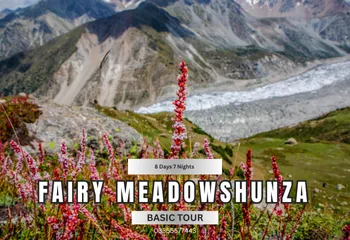Fairy Meadows – Shadows of Nanga Parbat
Table of Contents
Fairy Meadows is in the core of magnificent North Pakistan. It is renowned for its World’s ninth-biggest mountain, Nanga Parbat, and gorgeous, lush green plateaus. Fairy Meadows is situated in the Diamer District of the Gilgit-Baltistan region, Pakistan.
This place provides a stirring sight of Pakistan’s second-highest mountain, Nanga Parbat, which has an altitude of 8126 m. Due to its spell-bounding beauty, Australian climber Hermann Bhul named it Fairy Meadows in 1953.
He was there to climb the peak of Nanga Parbat and became the first person to summit the mountain. Besides nature lovers, the meadows have long been an electrifying destination for climbers, nature enthusiasts, environmentalists, backpackers, wildlife researchers, painters, photographers, and polo lovers who spend a couple of days there for real exploration. Fairy Meadows can easily be approached from the capital territory of Pakistan, Islamabad.
Fairy Meadows is like the bouquet before the towering killer mountain, Nanga Parbat. The mountain sets a backdrop for the Fairy Meadows, making it an appealing and exciting destination for tourists.
Fairy Meadows is where the legends of Nanga Parbat are kept alive, told by generations of villagers who had the chance to witness the legions of climbers who never descended its icy walls.
Nanga Parbat is the ninth tallest mountain in the world, standing at 8,125 meters. It is also the second tallest mountain in Pakistan, after K2. It is also the first mountain in the Great Himalayas range. The meadows change with the seasons. In autumn, the trees streak the mountains with a bright yellow, while winter is bare, bone white, and still.
Spring brings forth the river’s roar, the crisp cracks of avalanches, and the bloom of purple, yellow, and white wildflowers. Babbling brooks flow through the meadows, sparkling with stones like pyrite and quartz, but the snow remains glued to the mountain tops. Winter winds seldom visit in spring, howling through the log cabins at night.
Many tourists like to stay in camps in lush green places. In contrast to cities, food is a bit expensive here. But the availability of food at this far-flung place makes it worth paying. The six-month visitor season at Fairy Meadows starts in April and lasts until September.
The best time to visit Fairy Meadows is between the end of June and the middle of August. In winter, the place becomes unapproachable due to heavy snowfall. Tourist lodges at the camping site are spread over two acres and are well-known as ‘Raikot Serai.’
Most of all, houses are nestled amongst the mountains like hobbit holes, built out of pine logs with flattened birch barks used for the roof. The men play polo, sip tea, and cut firewood with the echoing thuds of their axes. The women pick wild mulberries, raspberries, and strawberries in the meadows and tend to their vegetable gardens.
In addition, at night, Nanga Parbat glows white in the still darkness, and men lounge on Pakistani rugs around small wood-fired iron stoves, relaying tales of the killer mountain.
However, the experience feels very safe, and the traveler should worry more about the cliffs and the biting cold at night rather than the possibility of terrorist attacks.
Hikers should take advantage of the pristine experience they can have while visiting this gem of a place.
Thus, from all the above information, it can be rightly said that Fairy Meadow is a heaven on earth. Lush green meadows in between the mighty creation of Almighty.









